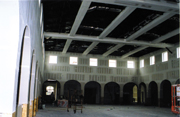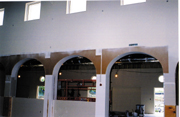

Down the long and linear path, great minds and hands from the architects and construction industry who have followed this historic tradition continue to produce efficient, sound-controlled, ornately beautiful and structurally stable units.
On the west coast of Florida, in Naples, Jeffrey Walls, of Schear Corp., has honored the practices of the Western civilization and has helped further advance its endeavors by employing software to meet the multi-faceted needs of such a facility.

The modern age
The North Collier Regional Library, also of Naples, is a 42,000 square-foot multi-roomed facility, complete with divided rooms for fiction and non-fiction, reading rooms, et al--including both a separate theater for adults and children.Contracted from Naples' general contracting company, Kraft Construction, under the direction of project manager Bob Schubring, Schear was contracted to do the metal framing, drywall application and finish work. It was a large job that needed not only various materials supplied, but all the fine-tuning arrangements to even approach a job this size. Schear utilized Advanced Estimating System and its program, The Edge for the project.
"In the library, we had many different assemblies," says Walls. "The Edge enables you to go into the system and create all these different assemblies. Once you get over the learning curve of the system--and you do need to create and know your database--you can create what you're actually doing in the field."
Through general research of what's available in the marketplace, Schear chose Advanced Estimating. One of the company's sales staff, John Lombardo, came out to Schear's offices and helped install the program and trained Walls with the system. After a little time to experiment with the program solo, Lombardo came back to educate Walls further on the systems capabilities.
"To learn the software takes about 100 hours," says Walls. "The company sends the staff out, customizing the system to your needs and instruct how to use it to your company's benefits."
Walls considers The Edge a tool equal to his hammer and drills.
"We're able to set up our job budgets by this estimating program," says Walls. "It's critical to the survival of our company. Everything's based on estimated cost.
"I can engineer and review the job right on the telephone with the customer to make anything work. You can download quotes, spreadsheets, material takeoffs and then e-mail this to your supplier. Pull up the file, read the material and grocery list as we're talking on the phone, and have the order completed. The Edge was a big investment for the company but I feel the program has paid for itself 10 times over."
For the $10 million job, Schear turned a profit with "a respectable margin and a very satisfied customer." To make these figures work without overhead or redos, The Edge displays approximate figures for material costs.
"To build a 3 5/8-inch partition wall that fits drywall, you would go into the database and create the assembly and in this assembly you would add in how many studs you want per foot. Then you calculate how much you plan to charge to hang all this. It calculates your material and labor. If you have change orders or job revisions, it subtracts very easily."

Information center
Schear began construction by doing the exterior walls with USG's Durarock. Fastening this to Dietrich's 16-gauge metal studs, the drywall work began. Lafarge Gypsum's 1/2- and 5/8-inch drywall was used. Keeping consistent with company products, Schear coated using Lafarge's Rapid Coat drywall joint compound. Schear practices the Gypsum Association's codes for Level 5 finish, so they completed the wall systems last two coats with Tool World's Spray Plast using Graco's line of pumps."One of the most difficult parts of this job were the 3-point arch system that had to be installed," says Walls. "There are 35 arches, each is 9 feet wide and 10 feet high; all had to be identical. We shot them all with a Hilti laser to match them all the same. We also had to coordinate with the wood windows to fit inside the arches. They're actually wood borrow light--(when you have a window in one room and you borrow the light from another room)--but only to find out that we were using inches. The wood carpenter gave us the wrong dimensions.
"What we did to rectify the problem was to have the carpenter help make us a template--two templates attached to each arch and we used USG Easy Sand to brand the arches (mudded) using the templates. We shot all the elevations with the templates, therefore we were able to make every one identical. It was very difficult."
"That was one of their worst challenges," says Dave Bamesberger AIA, project manager with architect firm Barany, Schmitt, Summers, Weaver and Partners Inc., of Naples. "These had to be very precise because of the millwork, and they performed the job very well."

Company collaboration
Another challenge of the job was to use all the key figures of the company. The average age of the workers on this job was 50 years old."I'm 35, my metal framing foreman is 65 and the drywall control man 70," says Walls. "Our company had to pull together to make this shine."
To Schear, everyone's important and input is equally a necessity as much as virtue. To date, the company employs 265 people.
Asked if he knew all those employees, Walls added: "One way I get to know my guys is by passing out paychecks each Friday. I get to listen to the complaints and other issues."
Another level of operation that Schear practices that Walls believes to be one of the company's powers are 6:30 a.m. conference calls. By making three-way calls, Walls and his crew outline the day's plans, where they have time to solve any problems and create scheduling.
"We're not concerned about all other people doing our punch list, we find our own defects before the general contractor or owner sees them," says Walls. "That way we have time to cover. The other key strategy is we're not afraid. We don't worry about getting someone else in trouble to make us look better. It's not about getting thrown under the bus, it's about understanding the mistake before it happens again."
The Collier Regional Library not only incorporated Hellenistic styles, but borrowed a thing or two from the Greek logic system. From the uninhibition of Phillip of Macedonia, the mathematics of Plato and the appeal of science and technology from Aristotle, Schears Construction is following the classic philosophy to advance ideas. The ideas Schear has presented with the work done on Collier's will help place themselves amongst the other chair holders of the construction pantheon--at least with the center of studies.
"We're always looking for new ideas to help us develop the company," says Walls. "We'll have to look for the next thing before everyone's doing what we are. We need new and different ideas to distinguish us from everyone else. It was a skilled craftsmanship of the key employees that made this happen."

